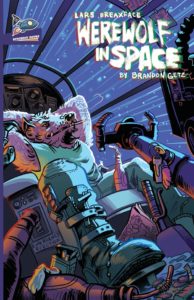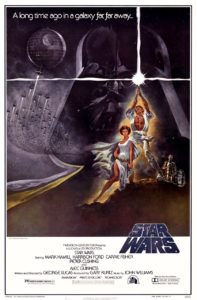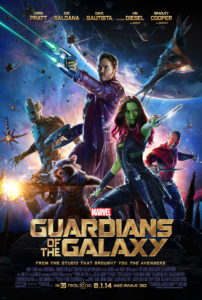One of the most common questions authors face is a deceptively difficult one to answer: “Where do you get your ideas?” Yet, the answers to that common question can be almost as interesting as the resulting story. Welcome to You’re My Inspiration, a new column dedicated to discovering what inspires a particular author and their work. Whether it be a lifelong love of mythical creatures, a fascinating bit of history, or a trip to a new and exciting place, You’re My Inspiration is all about those special and sometimes dark things that spark ideas and result in great stories.
This week, we bring you guest author Brandon Getz, whose debut novel, Lars Breaxface: Werewolf in Space, came out October 8th from Spaceboy Books!

Tom Sweterlitsch, author of The Gone World, says Lars Beaxface is “a teeth-gnashing action throwback; it’s grind house science fiction.” So how did Brandon create that grind house? Let him explain….
Everything is Remix
Pinning down every influence, reference, and easter egg in Lars Breaxface: Werewolf in Space is probably a fool’s errand. The story is a hodgepodge and a mishmash, drawing on every bit of horror and sci-fi and pop culture I’ve been ingesting since early childhood. When I started Lars Breaxface, I didn’t know what I was doing — all I had was a character and a first paragraph. A gruff, beer-guzzling wolfman chin-punching aliens in a space cantina. The kind of scene that feels right at home in Star Wars or Total Recall.
As the story progressed, I realized I’d unintentionally held on to the characters and worlds I’d created as a kid — the hulked-out werewolf superhero I’d drawn in my third-grade comics, the space mercenary adventures I’d written all through middle school, before I started reading serious™ literature and writing serious™ stories. Lars Breaxface is a story my pre-teen self would’ve loved, inspired by a lot of the same things that inspired me then: monsters, science fiction, comic books, and jokes ripped from the pages of Mad Magazine. Throw in some fancy wordsmithing and historical knowledge, a smattering of radical politics, and you’ve got this space opera exquisite corpse: The story of a werewolf and his ragtag team of Halloween characters, cracking dick jokes and punching things. As Chuck Wendig wrote in his review of Stranger Things:
“Everything is a remix, and that’s okay … It proves that it’s less about how original you are and more about how you rearrange the puzzle pieces to show a different image.”
Here are some of the things Lars Breaxface: Werewolf in Space remixes:
Star Wars/Guardians of the Galaxy: I’m putting these in the same top spot because James Gunn’s Guardians owes more than a bit to the classic trilogy, especially in the character of Star-Lord. (Don’t go nerd berserker on me — I know Peter Quill predates Han Solo in the comics, but the film iteration is absolutely a Solo clone.) Han is the quintessential space rogue, with imitations in Firefly, Killjoys, and a dozen other tales that center on a crew of morally ambiguous, wisecracking galaxy hoppers. Lars Breaxface fits the mold, and breaks (breax?) it — part Solo, part The Dude, part bloodthirsty anthropomorphic wolf.
The universe of Lars Breaxface also follows the blueprint of Star Wars and its ilk, with a wide open ‘verse populated by aliens of every form and locations ranging from neon cyberpunk to corners so gritty you need to brush your teeth after reading. The Guardians influences are a little more obvious. I didn’t intend it, but I did end up with a team comprised of one smartass space cowboy, one badass alien chick, one non-human comic relief character with weapons expertise, and one big tree creature. They’re also mostly based on classic monsters. Get over it.
 Monster Squad & Other B-movie Horror: Lars Breaxface is more often than not a straight-up space adventure. It was originally written as a serial, and that format lends itself well to planet-hopping, spacefaring, and a little transdimensional hocus pocus. But my lifelong love of horror and monsters infused every bit of it. The main character is a werewolf for Chrissake. When I was seven or eight, I got a copied VHS of Monster Squad from my stepdad — the movie sandwiched in between Home Alone 2 and Super Mario Bros. on an extended play tape. I can’t tell you how many times I watched that flick. Rudy was god, and Wolfman had nards, and Dracula was terrifying, and a portal opened up at the end as the kids fought to save the world.
Monster Squad & Other B-movie Horror: Lars Breaxface is more often than not a straight-up space adventure. It was originally written as a serial, and that format lends itself well to planet-hopping, spacefaring, and a little transdimensional hocus pocus. But my lifelong love of horror and monsters infused every bit of it. The main character is a werewolf for Chrissake. When I was seven or eight, I got a copied VHS of Monster Squad from my stepdad — the movie sandwiched in between Home Alone 2 and Super Mario Bros. on an extended play tape. I can’t tell you how many times I watched that flick. Rudy was god, and Wolfman had nards, and Dracula was terrifying, and a portal opened up at the end as the kids fought to save the world.
At this age, I was also watching Tales from the Crypt and a bunch of B-grade horror (Return of the Living Dead stands out) because my dad thought he’d be the cool parent in the divorce if he let me watch things no eight-year-old should be watching. I had plenty of nightmares, but I still loved it — then and now. Gimme Army of Darkness or Re-Animator over an Oscar winner any day. As much as Lars Breaxface is a space adventure, it’s got a creature feature vibe, with science-fictionalized iterations of those classic Universal monsters that I’d seen so many times in Monster Squad. It’s so creature feature, I even managed to get a blurb from B-movie horror legend Tom Atkins (The Fog, Halloween III), who said of the book, “I can’t wait to see the movie. Hell, I want to be in it,” which feels like the highest of praise. Hey, filmmakers who want to option Lars, here’s your voice for the minotaur.

Boissonnas et Eggler, St. Petersburg, Nevsky 24. – Bain News Service, publisher. [Public domain]
The ins and outs and what-have-yous of the plot mostly manifested as I wrote, but I was always moving toward this endgame: Anastasia prepares her whole life to avenge her dead family. But what does she do if her planet is actually better off without them? What kind of society could grow and prosper with monarchs out of the way? The book doesn’t dive too deep into it — it’s a monster adventure, and there are chins to punch and beers to drink. Lars Breaxface is political in the same way La Croix is a flavored beverage. There are hints, though, that I hope readers will mull over — of better worlds, of societies better off without evil bloodsuckers draining them dry.
 China Miéville: Before Lars Breaxface, I wasn’t a science fiction writer. I got an MFA, I wrote mostly about sad people in their sad lives. My stories existed in the borderlands between literary and genre, injecting weird and speculative elements into the mundane. A man’s midlife crisis unfolding in a taxidermy factory. A widower and his baby daughter visited by demons. A homunculus climbing out of the skull of a woman’s sick father. I was still a lover of science fiction movies, I had read plenty of sci-fi and horror as a kid, but in my twenties, my bookshelf trended more toward George Saunders, Margaret Atwood, Haruki Murakami, Kelly Link, and others who were respectable “literary” writers but obviously double-dipped in the genre realm.
China Miéville: Before Lars Breaxface, I wasn’t a science fiction writer. I got an MFA, I wrote mostly about sad people in their sad lives. My stories existed in the borderlands between literary and genre, injecting weird and speculative elements into the mundane. A man’s midlife crisis unfolding in a taxidermy factory. A widower and his baby daughter visited by demons. A homunculus climbing out of the skull of a woman’s sick father. I was still a lover of science fiction movies, I had read plenty of sci-fi and horror as a kid, but in my twenties, my bookshelf trended more toward George Saunders, Margaret Atwood, Haruki Murakami, Kelly Link, and others who were respectable “literary” writers but obviously double-dipped in the genre realm.
Then I read Perdido Street Station by China Miéville. What a wacky-ass book. Perdido, more than the other two installments of Miéville’s Bas-Lag series, is a kitchen sink of a book: cactus creatures, grotesque cyborgs, bug-headed women, hand-shaped mind-control parasites, sentient old computers, caterpillar demons, a reality-jumping world spider. It’s madness, told in prose with a musicality I hadn’t seen in fiction before. Miéville loves words, loves splicing them together and plucking them from old books and making them dance, and as I read them, I thought, This right here is what I want to be doing. I’ve read most of Miéville’s books by now, and some of them (Iron Council, Embassytown) are better, but Perdido Street Station was the first one to show me what was possible. When writing Lars Breaxface, if my prose felt stale, I’d find myself grabbing a Miéville book and reading a few chapters to get a feel for the shape of the words, the melody of them. Lars doesn’t resemble a Miéville book much — it certainly doesn’t foreground leftist politics like his do — but it is definitely a kitchen-sink book, with everything thrown in, and the prose shows a little of his influence.
Everything is remix. Lars Breaxface: Werewolf in Space remixes B-horror, space opera, Russian princesses, Miévillian sentence craft, and about a hundred pop culture nods to the ’80s and ’90s. If it had a soundtrack — and it does — it’d be a rollercoaster ride of psychobilly and dad rock, glam and Phantogram, Rocky Horror and horror surf. It’d be everything I love because that’s what Lars Breaxface: Werewolf in Space became: an ode to all my favorite pop trash. Crack open a cold beer and see if you can find it all.
 Brandon Getz earned an MFA in fiction writing from Eastern Washington University. His work has appeared in F(r)iction, Versal, Flapperhouse, and elsewhere. Lars Breaxface: Werewolf in Space, coming from Spaceboy Books October 2019, is his first novel. He lives in Pittsburgh, PA. Read more at www.brandongetz.com.
Brandon Getz earned an MFA in fiction writing from Eastern Washington University. His work has appeared in F(r)iction, Versal, Flapperhouse, and elsewhere. Lars Breaxface: Werewolf in Space, coming from Spaceboy Books October 2019, is his first novel. He lives in Pittsburgh, PA. Read more at www.brandongetz.com.
Photo by Hillary Lazar
Want to talk about what inspired you as a writer, and/or your current release? Check out our guidelines and fill out the form here.



Thank you so much for sharing your influences! And I have to say, talk about a memorable title for your book! Sounds like a riot!